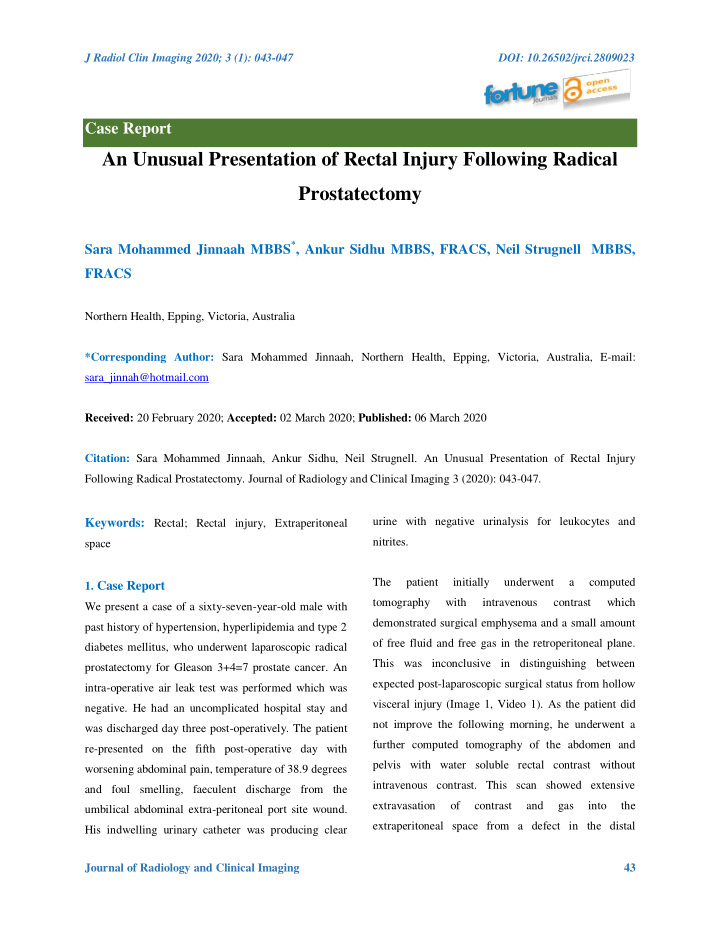



J Radiol Clin Imaging 2020; 3 (1): 043-047 DOI: 10.26502/jrci.2809023 Case Report An Unusual Presentation of Rectal Injury Following Radical Prostatectomy Sara Mohammed Jinnaah MBBS * , Ankur Sidhu MBBS, FRACS, Neil Strugnell MBBS, FRACS Northern Health, Epping, Victoria, Australia *Corresponding Author: Sara Mohammed Jinnaah, Northern Health, Epping, Victoria, Australia, E-mail: sara_jinnah@hotmail.com Received: 20 February 2020; Accepted: 02 March 2020; Published: 06 March 2020 Citation: Sara Mohammed Jinnaah, Ankur Sidhu, Neil Strugnell. An Unusual Presentation of Rectal Injury Following Radical Prostatectomy. Journal of Radiology and Clinical Imaging 3 (2020): 043-047. urine with negative urinalysis for leukocytes and Keywords: Rectal; Rectal injury, Extraperitoneal nitrites. space The patient initially underwent a computed 1. Case Report tomography with intravenous contrast which We present a case of a sixty-seven-year-old male with demonstrated surgical emphysema and a small amount past history of hypertension, hyperlipidemia and type 2 of free fluid and free gas in the retroperitoneal plane. diabetes mellitus, who underwent laparoscopic radical This was inconclusive in distinguishing between prostatectomy for Gleason 3+4=7 prostate cancer. An expected post-laparoscopic surgical status from hollow intra-operative air leak test was performed which was visceral injury (Image 1, Video 1). As the patient did negative. He had an uncomplicated hospital stay and not improve the following morning, he underwent a was discharged day three post-operatively. The patient further computed tomography of the abdomen and re-presented on the fifth post-operative day with pelvis with water soluble rectal contrast without worsening abdominal pain, temperature of 38.9 degrees intravenous contrast. This scan showed extensive and foul smelling, faeculent discharge from the extravasation of contrast and gas into the umbilical abdominal extra-peritoneal port site wound. extraperitoneal space from a defect in the distal His indwelling urinary catheter was producing clear Journal of Radiology and Clinical Imaging 43
J Radiol Clin Imaging 2020; 3 (1): 043-047 DOI: 10.26502/jrci.2809023 anterior rectal wall (Image 2, 3, Video 2). The patient contamination of the extraperitoneal space was treated was taken back to theatre for laparoscopic diversion by by open irrigation and drain placement. means of sigmoid loop colostomy. Extensive faecal Image 1: CT without rectal contrast showing small volume free fluid and free gas in the extraperitoneal and subcutaneous planes. Image 2: CT with rectal contrast demonstrating location of rectal injury. Journal of Radiology and Clinical Imaging 44
J Radiol Clin Imaging 2020; 3 (1): 043-047 DOI: 10.26502/jrci.2809023 Image 3: CT with rectal contrast showing extravasation of contrast into the retroperitoneal plane and out of the skin wound. Rectal injury is a rare and serious complication of tachycardia [3]. Our patient, in addition to having those radical prostatectomy [1, 2], the incidence of which is signs, also had the unusual finding of faeculant 0.5% [1]. It is more commonly seen in open rather than discharge from the umbilical port site. laparoscopic radical prostatectomy. Factors associated with a lower risk of rectal injury include robotic In these situations an abdominal computerized assisted laparoscopic radical prostatectomy, high tomography along with prompt surgical exploration is volume center and obesity (owing to increased recommended [3]. As barium enema is contraindicated perirectal adipose tissue potentially acting as a barrier when rectal injury is suspected, the addition of water- to injury) [3]. The probability of rectal injury during soluble contrast enema in the above case helped to prostatectomy may be influenced by previous TRUS better identify the rectal injury as well as its location (Transrectal ultrasound) guided biopsies which may and severity. A review of the literature does show that result in rectoprostatic adhesions. It is plausible that the use of rectal contrast does improve detection of perineal biopsies may reduce this risk. rectal injury [4]. Identifying the exact anatomical location of injury and differentiating between Rectal injuries may be identified intraoperatively when extraperitoneal and intraperitoneal involvement may the anterior rectal wall is examined by laparoscopic help to guide operative approach and management [5]. visualisation and or with concurrent digital rectal exam. Air insufflation leak testing, as was done in this 2. Conclusion case, may also exclude or confirm the presence of The use of water soluble iodinated rectal contrast rectal injury. In situations where the injury is during abdominal computed tomography, in patients unrecognized intraoperatively or where a later with suspected rectal injury following radical ischaemic or thermal injury occurs, patients present prostatectomy, allows for better visualization and with signs of an atypical acute abdomen, fever and management of these injuries. Journal of Radiology and Clinical Imaging 45
J Radiol Clin Imaging 2020; 3 (1): 043-047 DOI: 10.26502/jrci.2809023 Video 1: CT with IV contrast and without rectal contrast showing small volume free fluid and free gas in the extraperitoneal plane. Video 2: CT with rectal contrast demonstrating location of rectal injury and extravasation of contrast in the the retroperitoneal plane and out of the skin wound via the extraperitoneal space. References 2. Redondo C, Rozet F, Velilla G, et al. 1. Mandel P, Linnemannstons A, Chun F, et al. Complications of radical prostatectomy. Arch Esp Incidence, Risk Factors, Management, and Urol 70 (2017): 766-776. Complications of Rectal Injuries During Radical 3. Canda AE, Tilki D, Mottrie A. Rectal Injury Prostatectomy. European urology focus. During Radical Prostatectomy: Focus on Robotic Netherlands 4 (2018): 554-557. Journal of Radiology and Clinical Imaging 46
J Radiol Clin Imaging 2020; 3 (1): 043-047 DOI: 10.26502/jrci.2809023 Surgery. European urology oncology. enema. J Emerg Trauma Shock 6 (2013): 213- Netherlands 1 (2018): 507-509. 215. 4. Tonolini M. Images in medicine: Diagnosis and 5. Weinberg JA, Fabian TC, Magnotti LJ, et al. pre-surgical triage of transanal rectal injury using Penetrating rectal trauma: management by multidetector CT with water-soluble contrast anatomic distinction improves outcome. J Trauma 60 (2006): 508-514. This article is an open access article distributed under the terms and conditions of the Creative Commons Attribution (CC-BY) license 4.0 Journal of Radiology and Clinical Imaging 47
Recommend
More recommend